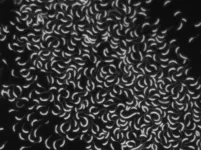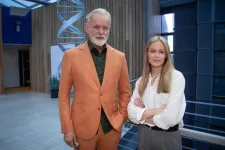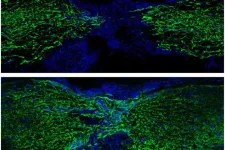(Press-News.org) **EMBARGOED UNTIL THURSDAY, AUG. 15, AT 9 A.M. ET**
In what they labeled a “surprising” finding, Johns Hopkins Medicine researchers studying bacteria from freshwater lakes and soil say they have determined a protein’s essential role in maintaining the germ’s shape. Because the integrity of a bacterial cell’s “envelope” or enclosure is key to its survival, the finding could advance the search for new and better antibiotics.
The research, described August 15 in the journal mBio, suggests that loss of a protein called OpgH in a widely studied bacterium known as Caulobacter crescentus creates a cascade of activity that disrupts the bubble-like cell envelope protecting the bacterium, resulting in the cell’s death. OpgH is an enzyme that creates glucose-containing molecules known as osmoregulated periplasmic glucans, or OPGs, which fill up the gelatinous in-between spaces of the protective cell envelope.
“In our experiments, when we get rid of the protein OpgH in Caulobacter bacteria, which halts production of OPG sugar molecules, the bacteria can’t survive,” says senior study author Erin Goley, Ph.D., professor of biochemistry at the Johns Hopkins University School of Medicine.
While Caulobacter crescentus bacteria themselves are not generally thought to cause diseases, OPGs found abundantly in gram-negative bacteria — bacteria in an enclosed shell-like membrane — play a role in antibiotic resistance and disease outcomes.
As a result, efforts to better understand the role of the sugar molecules in gram-negative bacteria, including Caulobacter, are seen as a way to aid in the development of new drugs that target disease-causing bacteria that have OPGs, including Brucella, Pseudomonas, Salmonella and E.coli.
If it’s true that the proteins that make or modify these sugar molecules are essential to bacterial survival, Goley notes, they could be good drug targets for antibiotics themselves. Or, in organisms where OPGs are not essential, a drug that targets some part of the OPG pathway might sensitize the cells to existing antibiotics, she says.
In this study, scientists used a molecular tool called an inducible promoter, dialing down the presence of the OpgH protein in Caulobacter to observe the effects on the shape of the bacteria cell and how loss of the OpgH protein affects a signaling pathway known as CenKR, which identifies and repairs problems in the cell envelope. They also manipulated the cell to make too much of the protein CenR, thus hyperactivating the CenKR pathway responsible for regulating the shape of the cell envelope.
After dialing up or down the OpgH or CenR proteins, scientists placed the bacteria cells on a pad of gel that prevented them from moving. Then, researchers used a specialized microscope to observe their shapes and activities.
“We found that they became misshapen as we dialed down the OpgH protein and halted production of sugar OPG molecules, or hyperactivated the CenKR signaling pathway that maintains the cell envelope,” Goley says.
“Then we also looked at where some of the molecular players that helped to grow the cell and keep the shape of the cell were located,” she says. “The molecular players were not in the correct locations, suggesting that OpgH and CenR are integral to maintaining the cell’s shape.”
Once the cell envelope loses its shape, all of the bacteria eventually burst open and die, Goley says.
“We established a model for how either depleting OPGs or activating the signaling pathway affects cell shape and growth,” Goley says.
While characterizing the sugar molecule’s role in Caulobacter’s cell structure is an important first step, Goley cautioned that “it will take some time to develop a complete picture about how they function across gram-negative species of bacteria.”
In Caulobacter, the sugar molecules resemble closed rings, and in E. Coli, they look like trees, with branches sticking off of chained structures. Understanding their shape and all of the decorations that associate with the molecules can help researchers characterize the cell envelope, she says.
“In the next phase of research, we hope to investigate all of the enzymes that make, decorate and break down these molecules — so we can get a full picture of their metabolism and how they maintain the cell envelope,” Goley says. “Once we uncover how these enzymes function, that’s great, because those are things drugs can target.”
Other scientists who contributed to this research include co-first authors Allison Daitch and Erika Smith, both recent doctoral graduates in Goley’s lab at Johns Hopkins Medicine, and now at the Biomedical Advanced Research and Development Authority at the U.S. Department of Health and Human Services and the National Institutes of Health, respectively.
Funding for the research was provided by the National Institute of General Medical Science (R35GM136221, T32GM007445).
DOI: 10.1128/mbio.01443-24
END
Surprise Finding in study of environmental bacteria could advance search for better antibiotics
2024-08-15
ELSE PRESS RELEASES FROM THIS DATE:
A genetic analysis of lyme disease could improve diagnosis and treatment
2024-08-15
A genetic analysis of Lyme disease bacteria may pave the way for improved diagnosis, treatment and prevention of the tick-borne ailment.
By mapping the complete genetic makeup of 47 strains of Lyme disease-causing bacteria from around the world, the international team has created a powerful resource for identifying the specific bacterial strains that infect patients. Researchers said this could enable more accurate diagnostic tests and treatments tailored to the exact type or types of bacteria causing each patient’s illness.
"This comprehensive, high-quality sequencing investigation of Lyme disease and related bacteria provides the foundation to propel the field forward,” ...
Scientists map DNA of Lyme disease bacteria
2024-08-15
A team led by CUNY Graduate Center biologists has produced a genetic analysis of Lyme disease bacteria that may pave the way for improved diagnosis, treatment, and prevention of the tick-borne ailment.
Weigang Qiu, a professor of Biology at the CUNY Graduate Center and Hunter College, and an international team including lead author Saymon Akther, a former CUNY Graduate Center Biology Ph.D. student, mapped the complete genetic makeup of 47 strains of Lyme disease-related bacteria from around the world, creating a powerful tool for identifying the bacterial strains that ...
Researchers awarded $2.8M federal grant to study potential treatment of Sudden Infant Death Syndrome
2024-08-15
CLEVELAND—More than 3,400 Sudden Unexpected Infant Deaths are reported annually in the United States, making it the country’s biggest cause of death of infants from 1 month to 1 year old, according to the Centers for Disease Control and Prevention (CDC).
Most of these deaths are classified as Sudden Infant Death Syndrome (SIDS), a disorder with numerous, unexplained causes that have plagued researchers for decades.
Now, with a new five-year, $2.8 million grant from the National Institutes of Health, researchers from Case Western Reserve University and University Hospitals Rainbow Babies ...
Blood pressure levels impacted by chronic occupational noise exposure
2024-08-15
Noise exposure is a known occupational hazard in some jobs, particularly for hearing loss, physical and psychological stress, and reduced concentration. A new study presented at the ACC Asia 2024 conference found in adult power loom weavers, chronic noise exposure not only increased their blood pressure overall, but also each year of exposure increased their odds of having high blood pressure by 10%.
“While the mechanism is still not well-explored, it is thought that the stress response by the body to chronic sound exposure causes hormonal imbalances that gradually leads to a permanent elevation of blood pressure,” said Golam Dastageer Prince, MBBS, MPH, medical officer ...
New study finds chronic high caffeine consumption may heighten risk for cardiovascular disease
2024-08-15
From coffee to tea, caffeinated beverages are an integral part of morning routines across the globe, but these popular drinks can be harmful when enjoyed in excess. According to a new study being presented at ACC Asia 2024 in Delhi, India, drinking over 400 mg of caffeine per day on most days of the week could increase the susceptibility of otherwise healthy individuals to cardiovascular disease.
“Regular caffeine consumption could disturb the parasympathetic system, leading to elevated blood pressure ...
$1.2 million in federal funding to study women Veterans experiencing homelessness
2024-08-15
A first-of-its-kind study led by Lawson Health Research Institute is receiving $1.2 million in funding from the federal government, delivered through the Veteran Homelessness Program, to better understand homelessness amongst women in Canada who are military Veterans.
“This is an important and yet often invisible problem,” says Dr. Cheryl Forchuk, Lawson Assistant Scientific Director based at St. Joseph’s Health Care London’s Parkwood Institute and the study lead. “This is the first Canadian study to focus exclusively on women Veterans’ experience of homelessness. Gender matters, especially when we’re talking ...
Robot planning tool accounts for human carelessness
2024-08-15
PULLMAN, Wash. -- A new algorithm may make robots safer by making them more aware of human inattentiveness.
In computerized simulations of packaging and assembly lines where humans and robots work together, the algorithm developed to account for human carelessness improved safety by about a maximum of 80% and efficiency by about a maximum of 38% compared to existing methods.
The work is reported in IEEE Transactions on Systems Man and Cybernetics Systems.
“There are a large number of accidents that are happening every day due to carelessness – most of them, unfortunately, from human errors,” said lead ...
deCODE genetics: Rare sequence variants, that associate with a high risk of Parkinson‘s Disease
2024-08-15
Scientists at deCODE genetics, a subsidiary of AMGEN, have discovered rare sequence variants, predicted to cause a loss of function of ITSN1, that are associated with a high risk of Parkinson‘s Disease. The findings also support less studied pathways involved in the pathogenesis of the disease.
The study, published today in npj Parkinson‘s Disease, used whole-genome sequence data from Iceland (deCODE genetics), the UK (UK Biobank), and the US (Accelerating Medicines Partnership Parkinson‘s ...
Cleaning up the aging brain: Scientists restore brain's trash disposal system
2024-08-15
Alzheimer’s, Parkinson’s, and other neurological disorders can be seen as “dirty brain” diseases, where the brain struggles to clear out harmful waste. Aging is a key risk factor because, as we grow older, our brain's ability to remove toxic buildup slows down. However, new research in mice demonstrates that it’s possible to reverse age-related effects and restore the brain’s waste-clearing process.
“This research shows that restoring cervical lymph vessel function can substantially rescue the slower removal of waste from the brain associated with age,” said Douglas Kelley, PhD, a professor of Mechanical ...
Zebrafish use surprising strategy to regrow spinal cord
2024-08-15
Zebrafish are members of a rarefied group of vertebrates capable of fully healing a severed spinal cord. A clear understanding of how this regeneration takes place could provide clues toward strategies for healing spinal cord injuries in people. Such injuries can be devastating, causing permanent loss of sensation and movement.
A new study from Washington University School of Medicine in St. Louis maps out a detailed atlas of all the cells involved — and how they work together — in regenerating the zebrafish spinal cord. In an unexpected finding, the researchers showed that survival and adaptability of the severed neurons themselves is required for full spinal cord regeneration. ...






